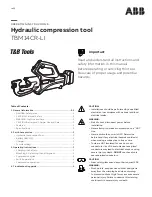
F
OR
M
ODELS
: JGI, JGM, JGN, JGP
AND
JGQ
PAGE 2-1
S
ECTION
2 -I
NSTALLATION
The installation of the compressor with the associated driver and piping, is to be done with
care and precision. This section addresses some of the more critical installation consider-
ations and requirements, but does not attempt to address all of the concerns that can arise.
The Skid or Package
Manufacture and install the skid or package in conformance to Ariel Packager Standards.
Lifting the Compressor
Determine the weight of the compressor, prior to lifting. For an accurate value, see the
Ariel
Performance Program
to determine frame and cylinder weights or for an approximate
weight of the compressor with cylinders see Technical Manual Section 1, Frame Specifica-
tions tables. Also account for any extra weight such as a flywheel, etc. Spreader bars should
be used to provide for a more vertical pull on the eyebolts or lifting lugs. Be sure that the
eyebolts or lifting lugs, lifting tackle, spreader bars and crane capacity are adequate and
properly rigged for the load. Keep the compressor level when lifting and setting. Heavier cyl-
inders and/or blank throws can significantly affect the center of gravity.
Do not attempt lifting by hooking to a compressor when the compressor is attached to the
skid, driver or piping. If you are not experienced in lifting large compressors, the use of qual-
ified professional riggers/movers is recommended.
On compressor frames designed for lifting lugs, install the lugs (4) with the proper Grade 8
cap screws and tighten to the torque value given in the Technical Manual Section 1 or the
tool box torque chart (the ER-63 chart is also available electronically at the Ariel web site:
), for lifting the compressor. If lifting lugs are already installed, recheck
fastener tightening torque. JGZ:U/4, KBB:V/4 and all 6-throw compressors have lifting lugs.
When lifting a compressor not designed with lifting lugs, lift by the eyebolts installed by Ariel
at the crosshead guides. Eyebolts installed in the crosshead guides by the Ariel Shop are
locked with Loctite to help prevent them from turning. Inspect eyebolts to be sure they are
free of any visual defects, such as bending, that could affect serviceability. Remove and
physically destroy any defective eyebolts. Replacement eyebolts are to be forged steel and
meet the requirements of ASME B18.15 latest edition (available at
threads and install a replacement eyebolt with Loctite #262 (available at
the same orientation as original eyebolt. Allow Loctite to cure before using a replaced eye-
bolt for lifting. For eyebolt load capacity rating and if pulling on an eyebolt in a direction other
than along the threaded axis, consult ASME B18.15.
The standard lifting lug and eyebolt materials can fail when subjected to shock loads at low
ambient temperature conditions. Follow the guidelines in ASME B18.15. If deemed neces-
sary by the customer or lifting professional, eyebolts may be replaced with forged eyebolts
of materials more suitable for low temperatures, in accordance with ASME B18.15 and
















































